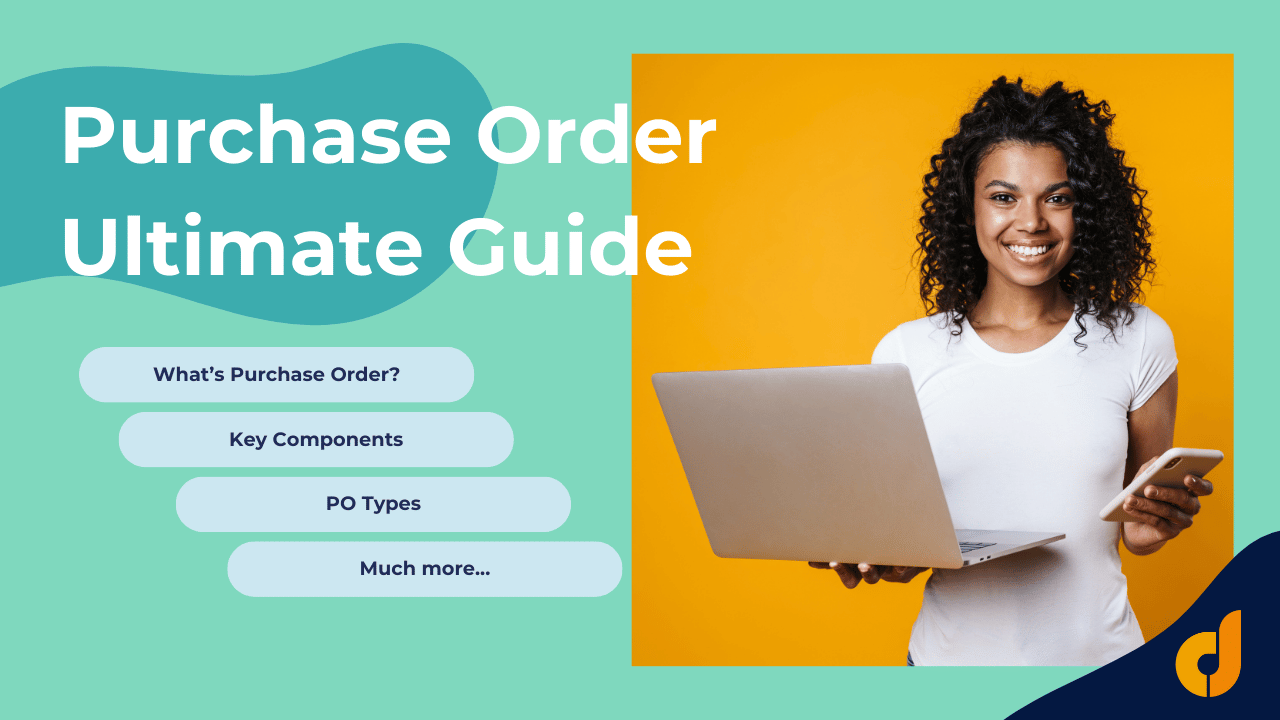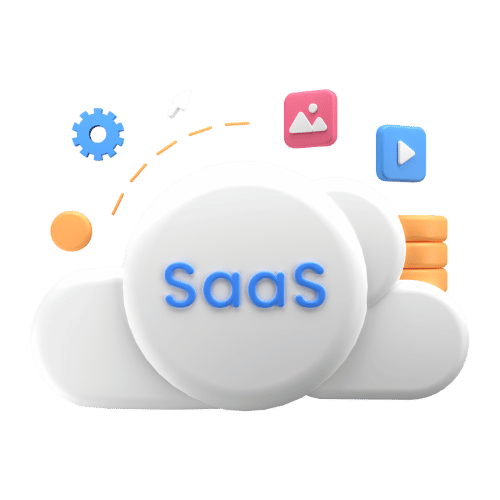Welcome to the ultimate guide to purchase orders! Whether you’re new to the concept or looking to refine your procurement process, this comprehensive guide covers everything you need to know about purchase orders. From their purpose to their benefits, creation process, and best practices, this guide is your one-stop resource. Let’s start our Purchase Order Ultimate Guide with a small definition.
What is a Purchase Order?
A purchase order (PO) is a formal document issued by a buyer to a seller, detailing the specifics of a purchase. It typically includes the type, quantity, and agreed-upon price of the goods or services. Purchase orders are an integral part of the procurement process, ensuring clarity, accountability, and efficiency between parties.
According to the purchase order definition, we are crystal clear that this is a document from the buyer to the seller to agree upon the purchase terms.
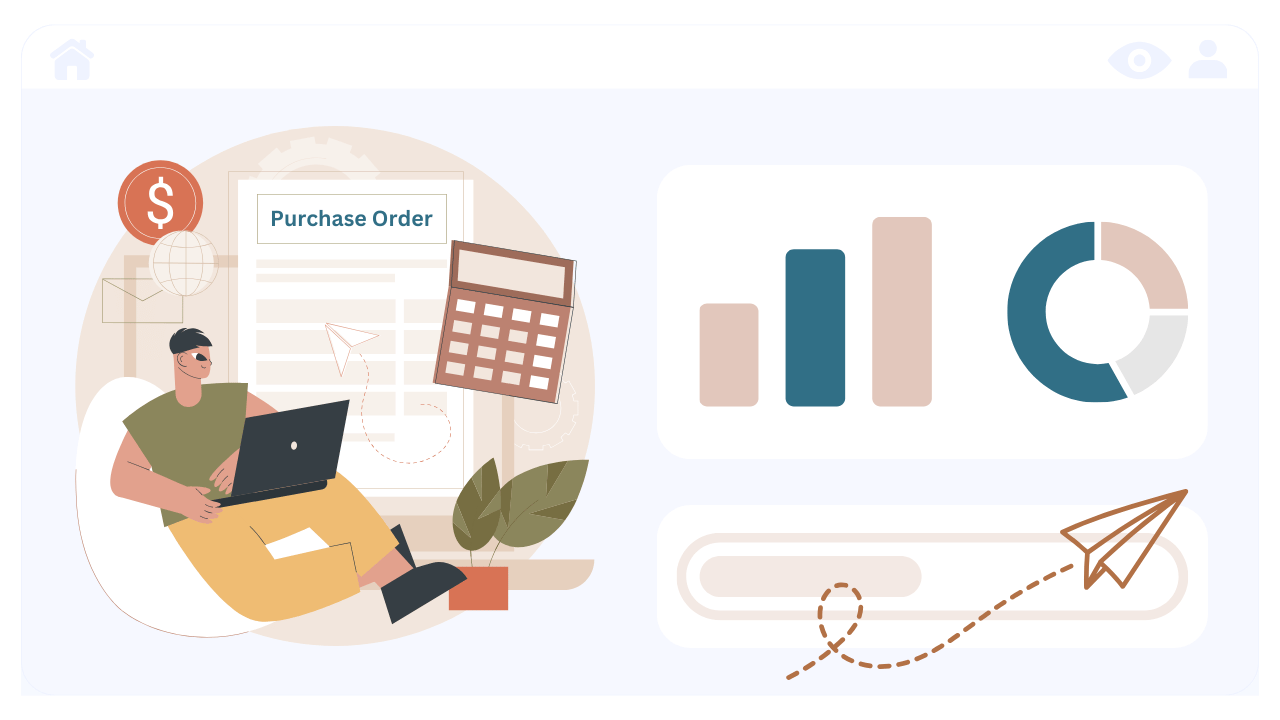
Why Are Purchase Orders Important?
Purchase orders provide multiple benefits for businesses, regardless of size.
Think of purchase orders as your business’s shopping list on steroids. Just like you wouldn’t want to forget your grocery list when heading to the supermarket, your business needs purchase orders to stay organized and avoid costly mistakes. They’re like a safety net that protects both buyers and sellers. This proves the importance of purchase orders.
When you use purchase orders, you’re basically telling your supplier exactly what you want, how much you’ll pay, and when you need it – all in writing. This prevents those awkward “but I thought you said…” moments that can cost your business time and money. It’s also a great way to keep track of your spending, like checking your bank statement but for future purchases.
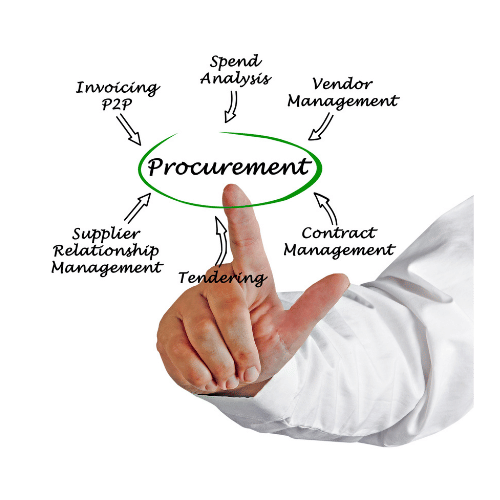 Plus, if there’s ever a dispute about what was ordered, you have a clear paper trail to fall back on. For growing businesses, purchase orders are especially valuable because they help manage cash flow – you know exactly how much money you’re committing to spend before you spend it. They also make life easier when it comes to tax time or audits, as all your purchasing decisions are documented and organized. Think of them as your business’s receipt before the actual receipt, keeping everything clear and professional between you and your suppliers.
Plus, if there’s ever a dispute about what was ordered, you have a clear paper trail to fall back on. For growing businesses, purchase orders are especially valuable because they help manage cash flow – you know exactly how much money you’re committing to spend before you spend it. They also make life easier when it comes to tax time or audits, as all your purchasing decisions are documented and organized. Think of them as your business’s receipt before the actual receipt, keeping everything clear and professional between you and your suppliers.
Here’s why they’re essential:
- Streamline Communication: They serve as a clear communication tool between buyers and suppliers, minimizing misunderstandings.
- Legal Protection: Once accepted, a PO becomes a binding contract that protects both parties.
- Financial Control: They help track spending and budget allocations effectively.
- Record Keeping: POs provide a clear audit trail for future references and compliance checks.
Without POs, businesses risk miscommunication, overspending, and inefficiencies in their purchasing process.
Key Components of a Purchase Order
Every purchase order should include the following essential elements:
- PO Number: A unique identifier for tracking purposes.
- Buyer and Seller Information: Full details of both parties, including names, addresses, and contact information.
- Item Description: Clear details of the products or services being purchased.
- Quantity and Unit Price: Exact numbers to avoid discrepancies.
- Total Amount: A summary of the total cost.
- Payment Terms: Agreed terms, such as net 30 or immediate payment.
- Delivery Date and Location: Where and when the items should be delivered.
- Additional Notes: Any specific instructions or terms for the supplier.
Purchase Order vs Invoice
The distinction between Purchase Orders vs Invoices is often misunderstood in business transactions. While a purchase order is a buyer-generated document specifying the intent to purchase goods or services, an invoice is a seller-generated document requesting payment for delivered goods or services. The timing also differs – POs are issued before the transaction, while invoices are issued after delivery. Understanding this difference is crucial for proper financial management and accounting practices.
Types of Purchase Orders
There are several types of purchase orders tailored to different business needs:
Standard Purchase Order:
The most common type for one-time purchases.
Blanket Purchase Order:
Used for recurring purchases over a specified period.
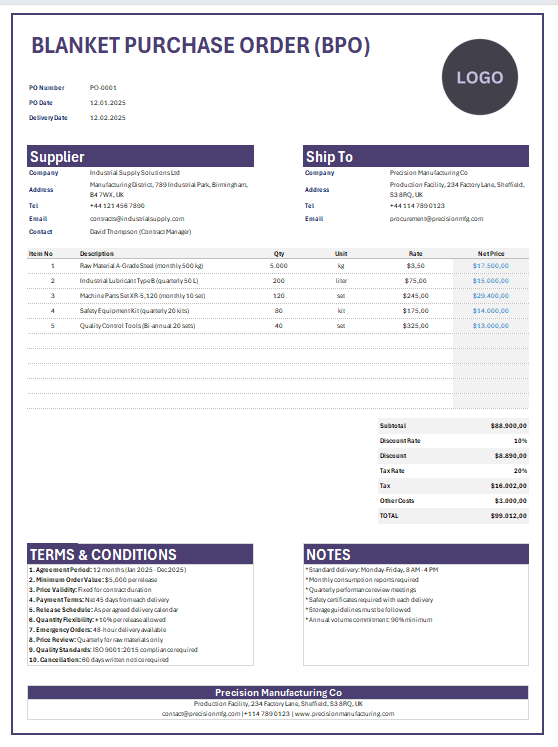 Contract Purchase Order:
Contract Purchase Order:
A legal agreement for future purchases.
Planned Purchase Order:
Created for anticipated needs but with flexible delivery dates.
Each type serves specific purposes, helping businesses manage procurement efficiently.
How to Create a Purchase Order?
Creating purchase orders in modern businesses has been streamlined through digital solutions. When preparing a professional purchase order, using the right template is crucial. Purchase Order Templates can be customized according to industry and specific needs.
![]() A basic template typically includes standard fields such as company logo, contact information, product table, and payment terms. Businesses can customize these templates to match their corporate identity and specific requirements.
A basic template typically includes standard fields such as company logo, contact information, product table, and payment terms. Businesses can customize these templates to match their corporate identity and specific requirements.
The process of creating a purchase order is straightforward but requires attention to detail. Here’s a step-by-step guide:
- Identify Your Needs: Clearly define the items or services you need, including quantities and specifications.
- Select a Supplier: Choose a reliable supplier and negotiate terms if necessary.
- Generate the PO: Use purchase order software like dashPO to create a professional document.
- Send the PO: Share the document with the supplier for approval.
- Track and Manage: Keep a record of the PO for tracking delivery and payment.
Using software like dashPO simplifies the process, reduces errors, and saves time.
Challenges in Purchase Order Management
Despite their advantages, managing purchase orders can present challenges:
- Manual Errors: Typos and data entry mistakes can cause costly misunderstandings.
- Approval Delays: Lengthy approval workflows can slow down procurement.
- Tracking Issues: Paper-based POs are difficult to organize and retrieve.
Automation tools like dashPO can help overcome these hurdles by digitizing and streamlining the entire process.
Best Practices for Purchase Order Management
To get the most out of your purchase orders, follow these best practices:
Standardize the Process: Use consistent templates and formats.
Automate Approvals: Implement digital workflows to speed up the purchase order approval workflow.
Maintain Clear Records: Ensure all POs are easily accessible and well-organized.
Regularly Review Policies: Adapt your process as your business grows.
Leverage Software: Use tools like dashPO to reduce manual work and improve accuracy.
The Purchase Order Process Flow must be properly structured. This flow typically includes request creation, approval, supplier selection, order creation, shipping, and payment stages. The Purchase Order Approval Workflow is particularly critical. A well-designed approval process prevents unnecessary delays and increases process transparency.
Digital Purchase Order Solutions automate these processes, significantly improving efficiency and reducing manual intervention.
Automating Purchase Orders has become essential for modern businesses, regardless of their size. Automation streamlines the entire procurement process, from requisition to payment. Key benefits include reduced processing time, eliminated paper trails, and improved accuracy.
Modern PO automation solutions offer features like mobile approval capabilities, real-time tracking, and integration with accounting systems. This digital transformation in purchase order management leads to significant cost savings and improved supplier relationships through faster processing and fewer errors.
Benefits of Using Purchase Order Software
You can use Excel templates to prepare your POs. But still the tracking is a problem. Especially, if you are a small business or startup with limited resources, then you can easily manage your procurement activities with a small business purchase order software.
Automating purchase orders offers numerous benefits:
- Error Reduction: Eliminates manual data entry mistakes.
- Time Savings: Speeds up the creation and approval process.
- Centralized Records: Keeps all purchase orders in one easily accessible location.
- Real-Time Access: Enables you to manage POs from anywhere.
If you’re looking for a free Purchase Order Software, dashPO is designed to provide all these benefits and more, making it an essential tool for modern businesses.
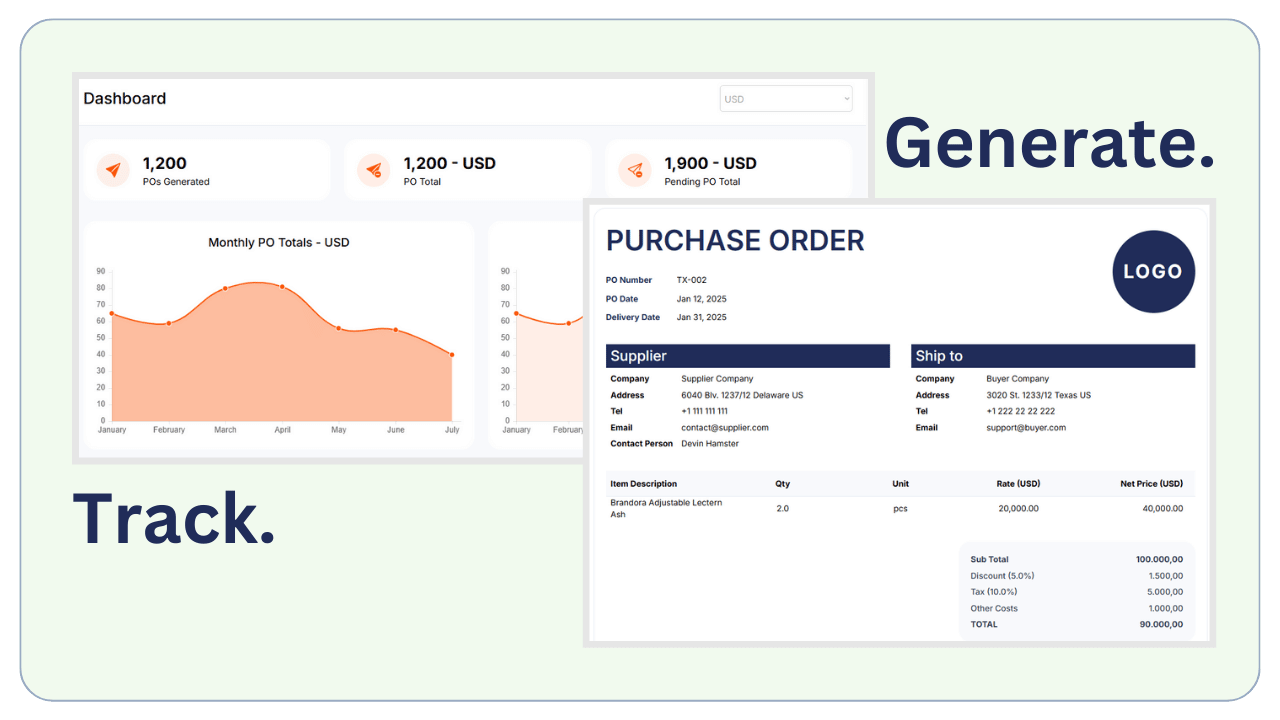
You can check DashPO Guide to learn more about this micro-SaaS solution to streamline your PO flows.
Common Questions About Purchase Orders
Here are some frequently asked questions on purchase orders:
-
What’s the difference between a purchase order and an invoice?
A purchase order is issued by the buyer to request goods or services, while an invoice is issued by the supplier to request payment for delivered items.
-
Do small businesses need purchase orders?
Yes! POs help small businesses maintain financial control and avoid disputes with suppliers.
-
Can purchase orders be canceled?
Yes, as long as both parties agree or the terms allow for cancellation.
Conclusion
Purchase Orders are surely essential for procurement management and every business will need to streamline PO process.
So, the digital purchase order solutions have revolutionized how businesses handle procurement. These solutions offer features like cloud storage for easy access, automated matching with invoices and receipts, and integration with inventory management systems.
They provide real-time visibility into spending patterns and commitments, enabling better financial planning and control. Advanced solutions also include features like vendor performance tracking, budget monitoring, and customizable approval hierarchies, making them invaluable tools for modern business operations.
A well-organized purchase order process is the backbone of efficient procurement. By adopting best practices and leveraging tools like dashPO, businesses can save time, reduce errors, and maintain better control over their spending.
Ready to optimize your procurement process? Start using dashPO today and experience seamless purchase order management like never before!

